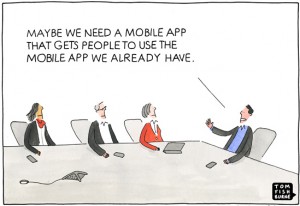5 Misconceptions About Mobile App Marketing That Can Stunt Valuable User Growth
— May 20, 2015
The mobile app market has expanded rapidly, with over 2 million apps available on the App Store and Google Play. For businesses and marketers, understanding their users is critical in this fiercely competitive space. As a co-founder at Gallop and a participant in the mobile application development industry, I’ve worked with businesses of all sizes to build, grow, and monetize their mobile presence. Mobile marketing has evolved significantly, especially in the last few years. Addressing common misconceptions is crucial for achieving mobile app marketing success.
Misconception #1: Inexpensive Users Equal High-Quality Users
Many mobile app marketers prioritize cost-per-install (CPI), aiming to acquire users at the lowest cost. This focus can be misleading. The critical question is whether you want cheap users or valuable ones. In industries like mobile gaming, top-performing users—often referred to as “whales”—drive the majority of revenue. For some apps, these users make up over 90% of total earnings. Therefore, the challenge is identifying strategies to attract more high-value users.
For apps reliant on purchases, marketers should optimize channels that promote spending. If ad engagement is the revenue driver, focus on users likely to stay engaged and interact with ads. Mobile attribution tools can analyze data to determine which marketing channels yield the most valuable users. For example, while working with an m-commerce app, we identified that specific Facebook ads led to the highest in-app purchases. By reallocating budgets and refining ad creatives, the app achieved a better return on investment (ROI).
Misconception #2: Focusing Solely on User Acquisition Grows Your Business
Many marketers believe acquiring new users is the key to growth. However, sustaining a business requires users who not only install the app but also engage with it and spend money. User lifetime value (LTV) must exceed acquisition costs to ensure profitability.
Research by Localytics reveals that 20% of users abandon an app after one use. Re-engaging existing users is significantly more cost-effective than acquiring new ones. Strategies like mobile app engagement ads, push notifications, and email campaigns can bring users back. Marketers can also leverage app data for precise retargeting, similar to website retargeting strategies. Deep-linking technology allows marketers to direct users to specific sections of the app, increasing the relevance of marketing messages. For instance, if a user starts a purchase flow, a push notification with a direct link to their cart can encourage completion, boosting revenue and retention.
Misconception #3: Mobile Analytics Tools Are Only for Product Teams
Marketers often overlook the value of mobile analytics, assuming it is only relevant to product teams. In reality, these tools offer insights into user behavior and can greatly enhance marketing strategies. They provide data on retention, engagement, and user flow, which can inform targeted campaigns.
Mobile analytics platforms track advertising IDs, such as iOS IDFA or Android ID, allowing marketers to understand user demographics, geographies, and behaviors. With look-alike modeling on platforms like Facebook, marketers can attract users who resemble their most valuable audience segments. Additionally, retargeting campaigns can re-engage specific user groups. For instance, one news app increased in-app subscriptions by over 30% using data-driven targeting without increasing ad spend. Similarly, a messaging app saw double-digit improvements in engagement metrics by analyzing and acting on behavioral data.
Misconception #4: Multiple SDKs Are Needed to Measure Attribution for Each Channel
A common belief among app marketers is that measuring attribution across channels requires multiple software development kits (SDKs). This perception complicates campaign management unnecessarily. A single mobile attribution SDK can efficiently track user acquisition and in-app behaviors across multiple channels, including paid and organic sources.
Using a unified attribution tool simplifies integration and provides comprehensive insights into campaign performance. For instance, when advertising on platforms like Facebook, Google, and Twitter, you can measure results without needing separate SDKs for each channel. Businesses should select attribution partners based on the breadth of channels covered, support services, and the ability to track key in-app events. By consolidating SDKs, apps can reduce technical complexity while improving their ability to assess ROI and optimize marketing strategies.
Misconception #5: Creative Development Is a One-Time Investment
In mobile marketing, relying on a single creative asset for an entire campaign is a missed opportunity. Unlike web banners, which can remain static for long periods, mobile ads require constant testing and iteration to remain effective. Users quickly grow indifferent to repetitive ads, making frequent updates essential for sustained engagement.
Testing different ad creatives, such as images and copy, allows marketers to determine what resonates best with target audiences. Refreshing ad content regularly can also lower marketing costs. For example, a client saw a 35% reduction in campaign expenses by updating their creatives consistently. Some platforms, like Facebook, reward relevance and freshness by increasing ad visibility. Tailoring creatives for each channel and user demographic ensures campaigns are as effective as possible, driving higher engagement and conversion rates.
Conclusion
Correcting misconceptions about mobile app marketing is vital for success. Marketers must prioritize high-quality user acquisition, re-engagement strategies, and data-driven targeting. They should also embrace unified attribution tools and iterative creative development to optimize campaigns. By addressing these challenges, businesses can build effective strategies that drive growth, engagement, and revenue.
Emphasizing insights from web and mobile development services can provide additional expertise in achieving scalable results.








